Bánh bột lọc (Vietnamese clear shrimp and pork dumplings or Hue’s tapioca dumplings), is a traditional Vietnamese delicacy from Hue, known for its unique, chewy texture and savory fillings.
In Hue, there are two types of bánh bột lọc: bánh bột lọc lá (one wrapped in banana leaves) and one unwrapped (bánh bột lọc trần).
Today’s recipe will focus on bánh bột lọc trần, the unwrapped version. This style showcases the translucent, glossy appearance of the tapioca dough, which encases a flavorful blend of shrimp and pork.
Get ready to dive into the preparation of this authentic Hue cuisine. I’ll guide you through the ingredients needed, the step-by-step process, and some tips to make your dumplings perfect.
Let’s start cooking!
Bánh Bột Lọc: Vietnamese Little Dumplings with Big Flavor
Bánh bột lọc is a traditional Vietnamese dumpling from Hue, a city once the imperial capital under the Nguyen Dynasty. These small, chewy dumplings are made from tapioca starch, giving them a unique, translucent appearance. Typically, they are filled with a savory mix of shrimp and pork.
This dish was likely developed to cater to the refined tastes of the royal family but has since become a beloved part of everyday Vietnamese cuisine.
You can find bánh bột lọc in two styles: one wrapped in banana leaves (bánh bột lọc lá), which infuses the dumplings with a subtle, earthy aroma, and the other served unwrapped (bánh bột lọc trần), showcasing their glossy, jelly-like texture.
Both versions are usually enjoyed with a zesty dipping sauce made from fish sauce, garlic, chili, and sugar, which perfectly complements the dumplings’ mild flavors.
Whether wrapped or unwrapped, bánh bột lọc offers a delightful taste of Vietnamese tradition, perfect for a light snack or a festive treat.
What Are Must-Have Equipment for Bánh Bột Lọc Preparation?
To craft the perfect bánh bột lọc, ensure you have the following tools ready:
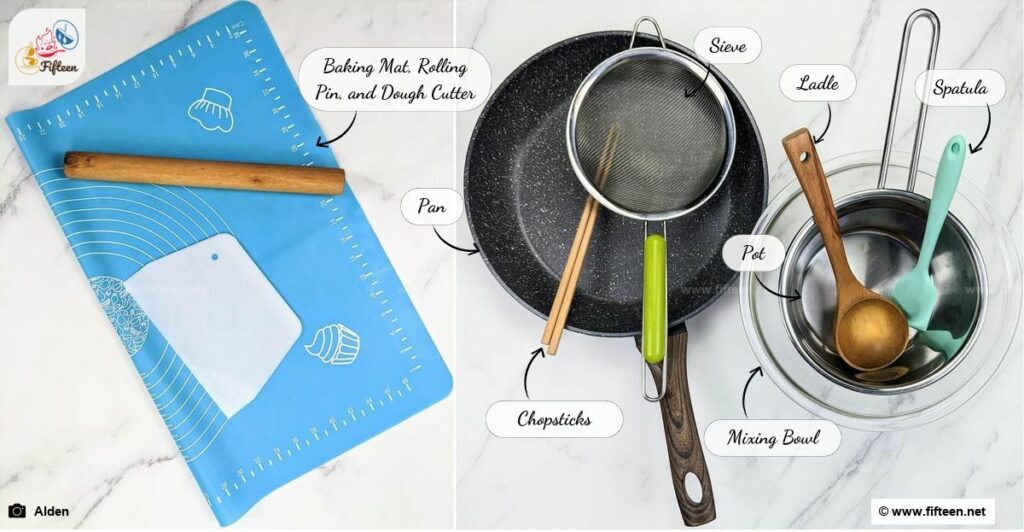
All You Need: Ingredients for Bánh Bột Lọc
Gather the following ingredients to prepare the delectable Vietnamese clear shrimp and pork dumplings:
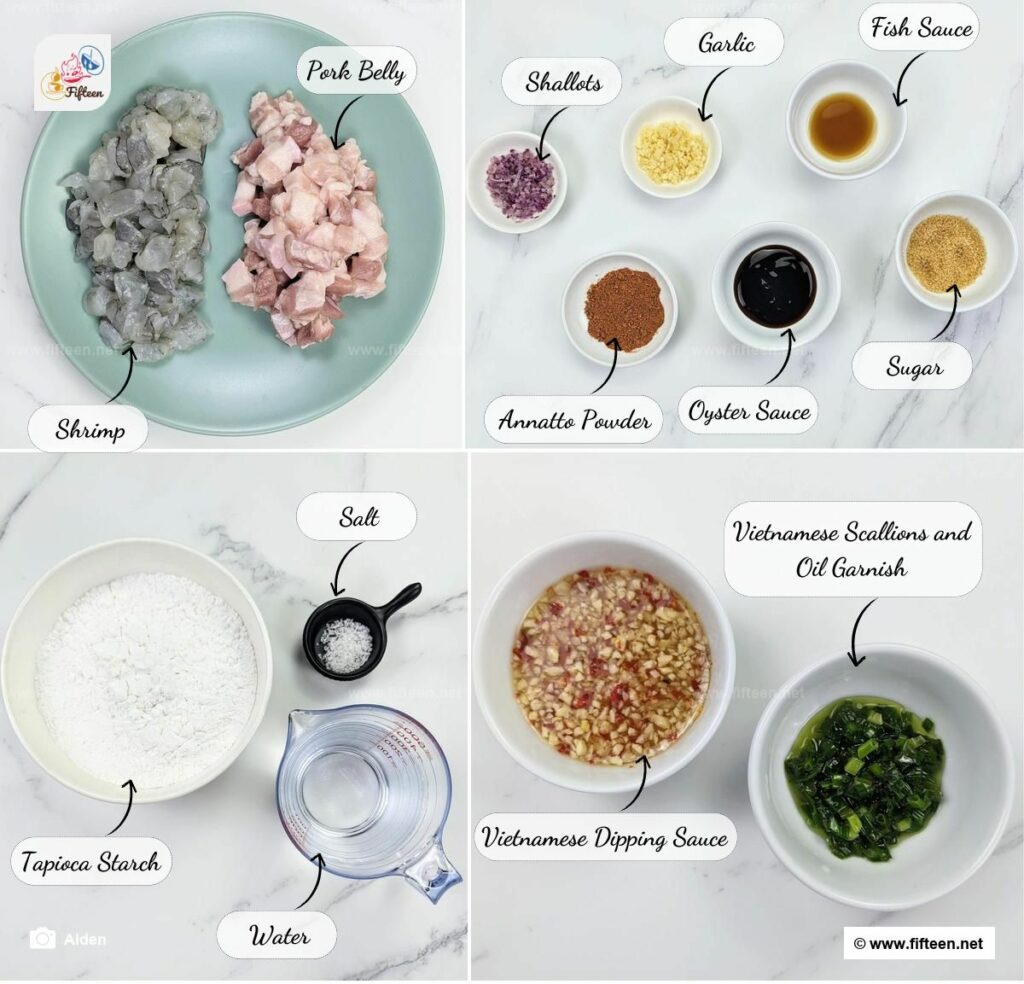
Step-by-Step Guide to Making Bánh Bột Lọc
Creating bánh bột lọc involves a detailed process broken down into 5 manageable steps:
Step 1: Making the Filling
Begin by heating a touch of oil in your pan—just enough to get things sizzling. Toss in shallots and garlic, and let them fry gently until their enticing aroma fills the kitchen.
Add pork and cook until no traces of pink remain.
Then toss in the shrimp.
Follow by mixing:
Next, add 1.5 teaspoons of annatto powder. Stirring until everything melds together into a fragrant, savory mix.
Step 2: Preparing the Dough
In a large mixing bowl, combine 0.66 ounces of tapioca starch with 1 teaspoon of salt. Blend these dry ingredients until they’re well mixed.
Next, gradually incorporate 1 cup of warm water into the bowl. Add the water in three equal parts, about 0.33 cups at a time. After each addition, stir swiftly with a spatula to ensure the ingredients combine evenly.
Once the mixture cools slightly, it’s time to get hands-on. Knead the dough with your hands. If it feels too dry, sprinkle a little more water; if it’s too sticky, a bit more tapioca starch can help.
Continue kneading until the dough becomes smooth and elastic, no longer sticking to your hands, and can be easily stretched into long strands.
Step 3: Shaping the Dumplings
Now, divide your dough into equal portions. Cover these with plastic wrap to keep them from drying out.
Take each portion and break it down into smaller pieces—each about the size of a marble or slightly bigger.
Roll each piece into a ball, flatten it, and gently roll it out so that the edges are thinner than the center.
Lay the flattened dough in your palm, and using chopsticks, place a mix of shrimp and pork in the center.
Carefully fold the dough over the filling, using the chopsticks to help you tuck and seal the edges, creating a neat half-moon shape.
Continue this process until all your dough and filling are used up.
Step 4: Cooking the Dumplings
Get ready to cook the dumplings by preparing a bowl of ice water and bringing a pot of water to a gentle boil.
Drop the dumplings into the boiling water and let them cook for about 5-7 minutes until they are fully cooked.
Once done, immediately transfer the dumplings into the ice water. This stops the cooking process and keeps the dumplings firm.
After cooling, remove the dumplings with a sieve or a slotted spoon to a bowl and drizzle a little oil over them to prevent sticking.
Step 5: Serving
Serve the dumplings warm, topped with scallion oil and a side of chili garlic sauce.
Sit back and enjoy the fruits of your labor—an authentic taste of Vietnam right in your own home!
Insider Tricks for Flawless Vietnamese Clear Shrimp and Pork Dumplings
Here are some useful tips to make your bánh bột lọc stand out:
Ready to Make Bánh Bột Lọc?
Bánh bột lọc is a delightful treat that’s perfect for sharing with friends and family. Its unique texture and flavorful filling make it a standout dish at any gathering. Give this recipe a try and see how these little dumplings bring big smiles!
Don’t forget to like and comment on your experience making bánh bột lọc. Share this recipe with others and spread the joy of cooking something special and delicious. Your feedback is invaluable and helps me grow in my culinary journey!
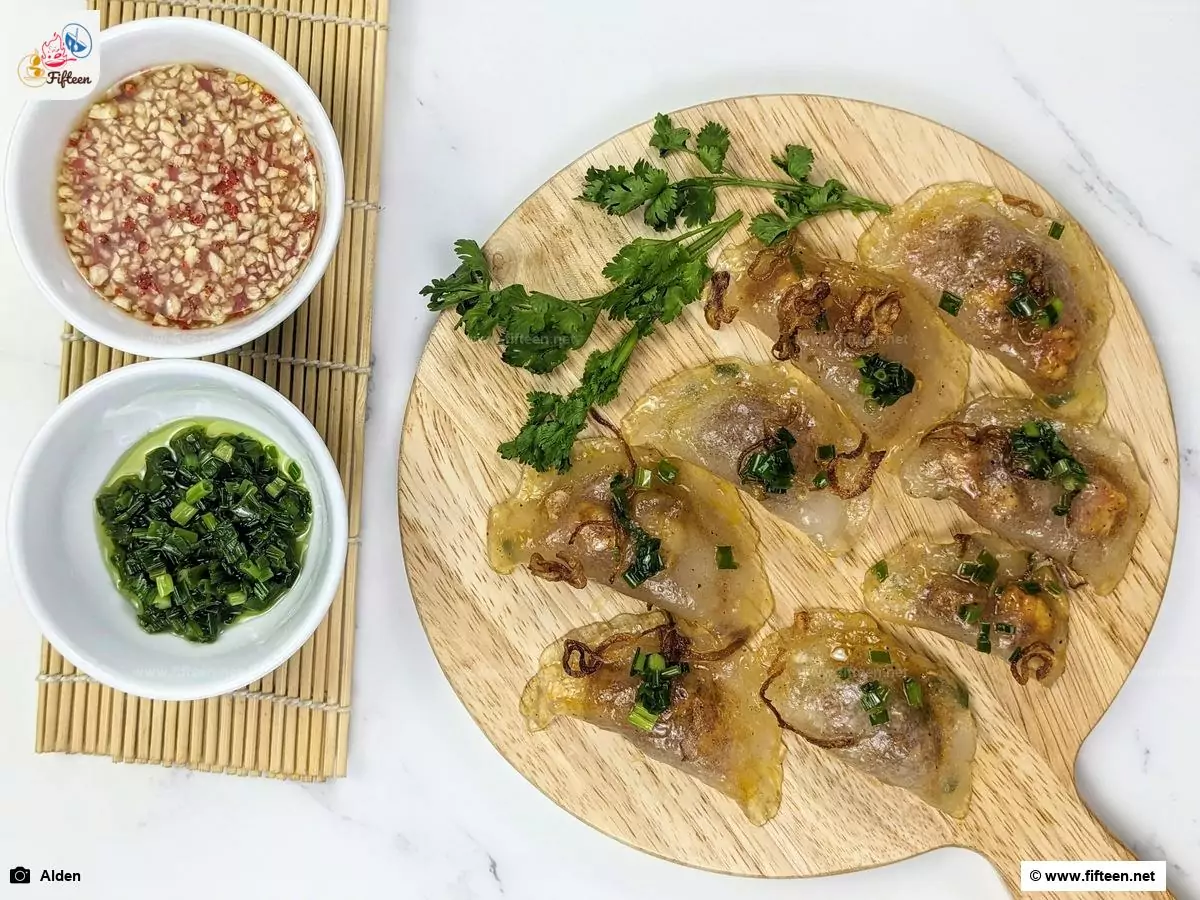
Bánh Bột Lọc Recipe (Vietnamese Clear Shrimp and Pork Dumplings)
Equipment
- Pan
- Pot
- Mixing Bowl
- Spatula
- Chopsticks
- Baking Mat
- Rolling Pin
- Dough Cutter
- Sieve
- Ladle
Ingredients
For the Dough
- 0.66 ounces tapioca starch
- 1 teaspoon salt
- 1 cup warm water
For the Filling
- 5.3 ounces pork belly, diced
- 5.3 ounces shrimp, diced
- 1.5 teaspoons minced shallots
- 1.5 teaspoons minced garlic
- 1 teaspoon fish sauce
- 1.5 teaspoons annatto powder
- 1.5 teaspoons sugar
- 1 teaspoon oyster sauce
For Accompaniments
- Vietnamese dipping sauce (nước chấm)
- Scallion oil (sốt mỡ hành)
Instructions
Prepare the Filling
- Heat a small amount of oil in a pan. Sauté minced shallots and garlic until fragrant. Add diced pork, cooking until it firms up.
- Then incorporate diced shrimp.
- Stir in fish sauce, sugar, and oyster sauce.
- Add annatto powder, and cook until the filling is well-combined and aromatic.
Prepare the Dough
- Mix tapioca starch and salt in a large bowl.
- Pour 1 cup of warm water into the bowl in three separate additions, using about 0.33 cups each time. Stir quickly after each pour to blend the ingredients evenly.
- Once the mixture is cool enough to handle, knead it with your hands. Add more water if it’s dry or more starch if it’s sticky.
- Keep kneading until the dough is smooth and elastic.
Shape the Dumplings
- Divide the dough into equal portions and cover with plastic wrap to prevent drying.
- Take each portion, break it into small marble-sized pieces.
- Roll them into balls, and flatten them so the edges are thinner than the center.
- Place the flattened dough on your palm, add shrimp and pork filling in the center, and fold the dough over the filling.
- Press the edges together to seal into a half-moon shape.
Cook and Enjoy
- Prepare a bowl of ice water.
- Fill a pot with water and bring to a gentle boil. Add the dumplings and boil for about 5-7 minutes until cooked.
- Transfer the cooked dumplings to a bowl of ice water to stop the cooking process.
- Drain the dumplings and toss with a bit of oil to prevent sticking.
- Serve hot, topped with scallion oil, and accompanied by chili garlic sauce.
Video
Notes
- You can make a batch and freeze them for later use. Thaw in the refrigerator and reheat by steaming.
- Alternatively, arrowroot flour can be used instead of tapioca starch.
- Ensure the filling is not too moist to prevent the dumplings from becoming soggy.
- Keep the cooked dumplings in cold water only briefly to maintain their texture.
- For an authentic touch, serve with a side of pickled vegetables.


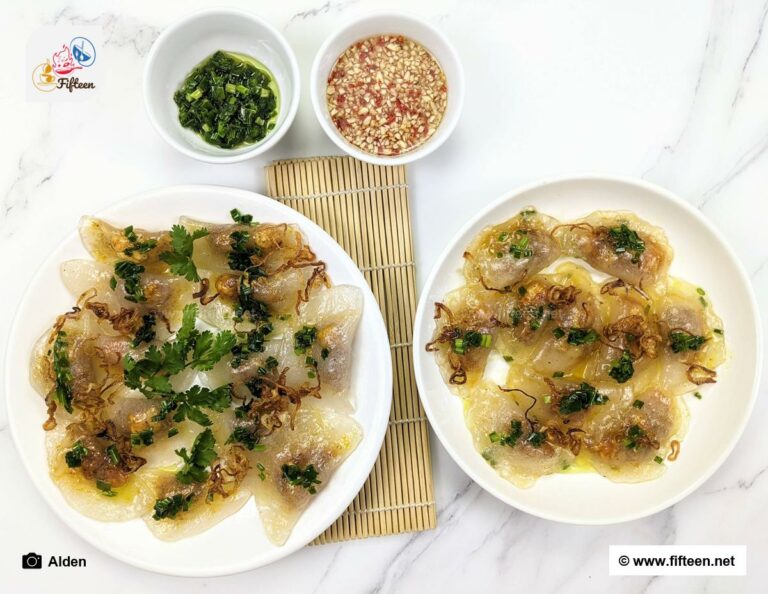
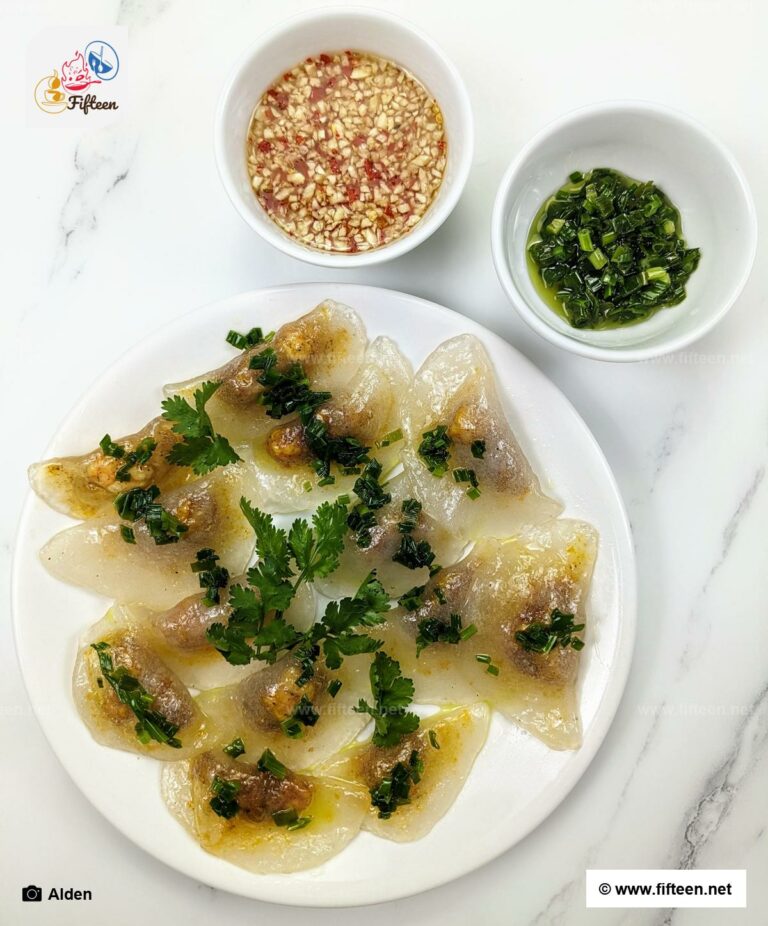
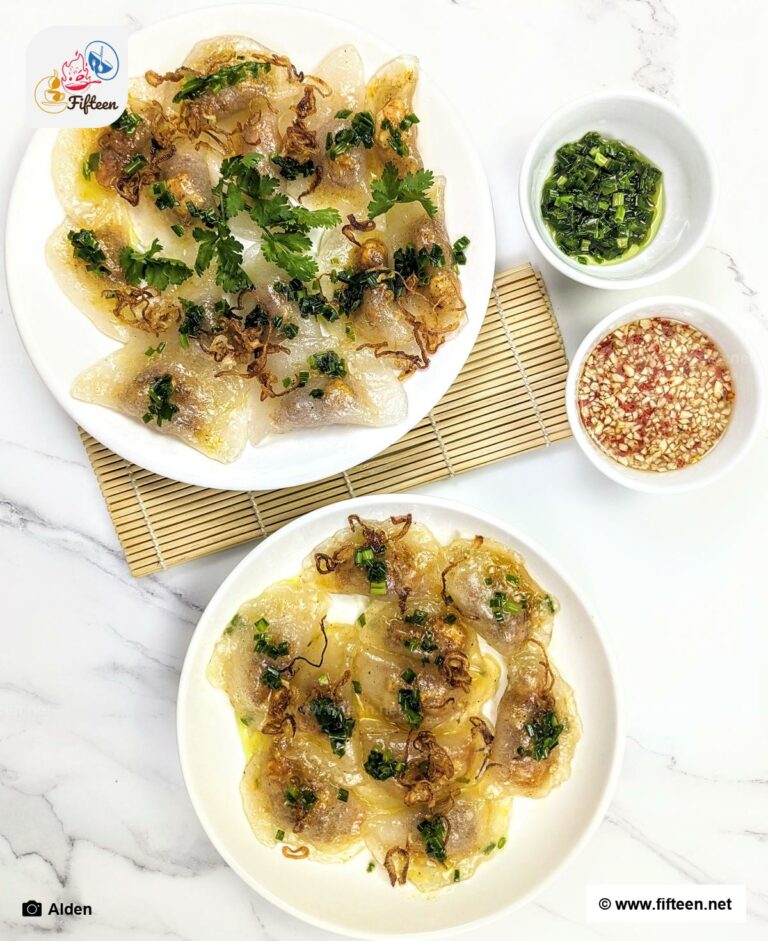
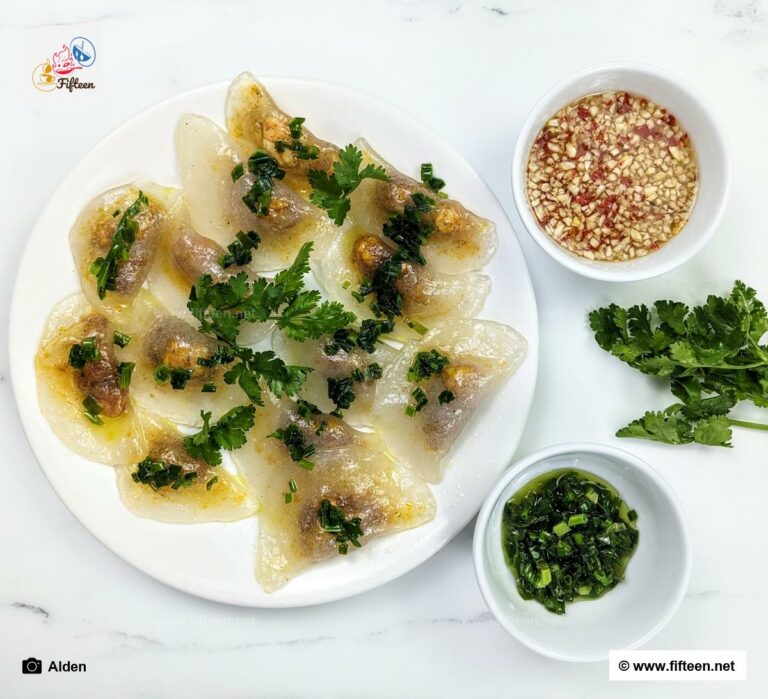
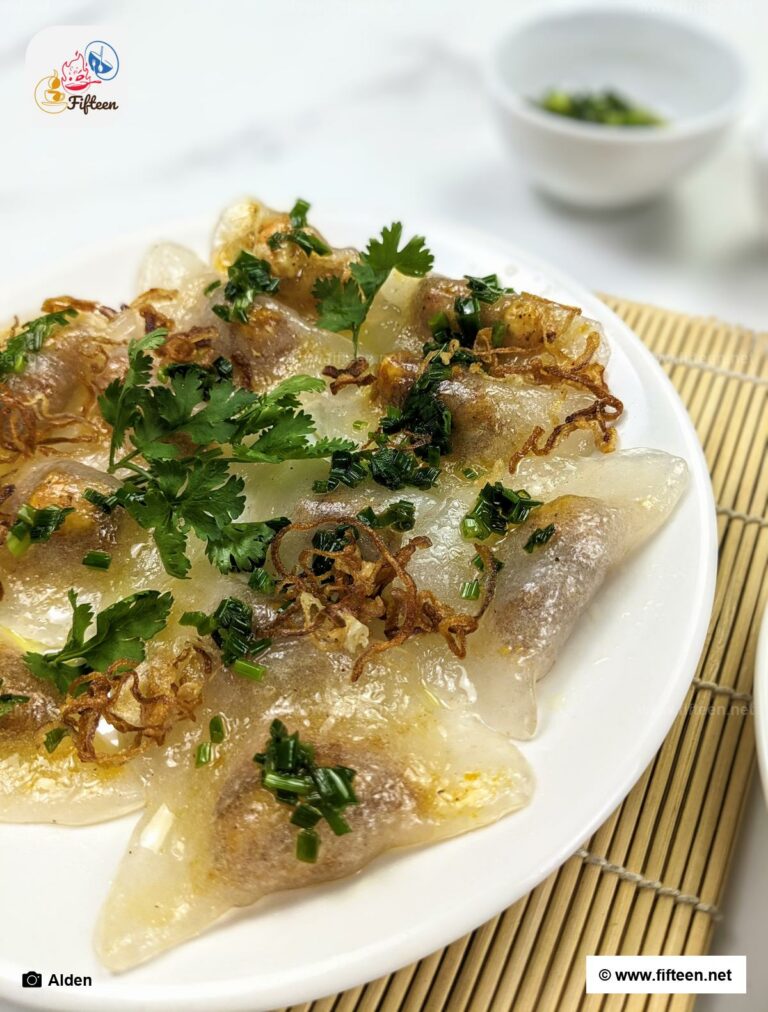
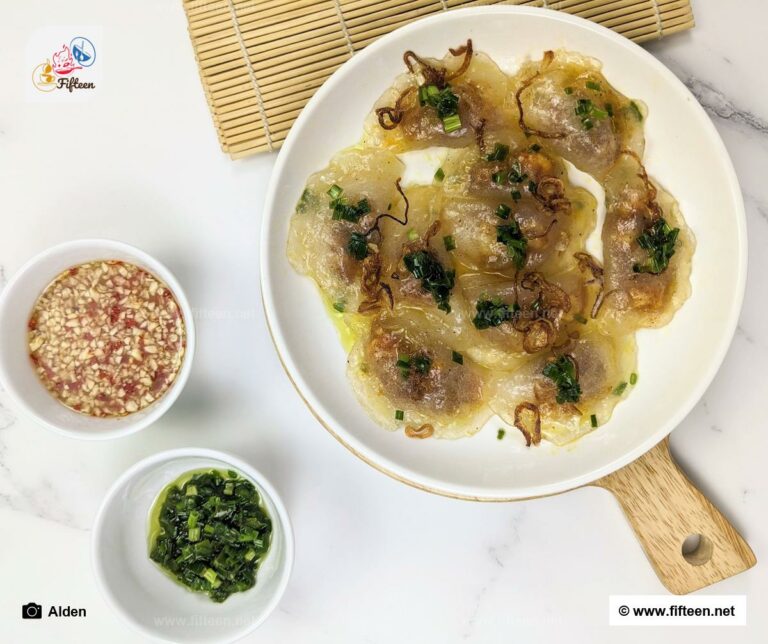
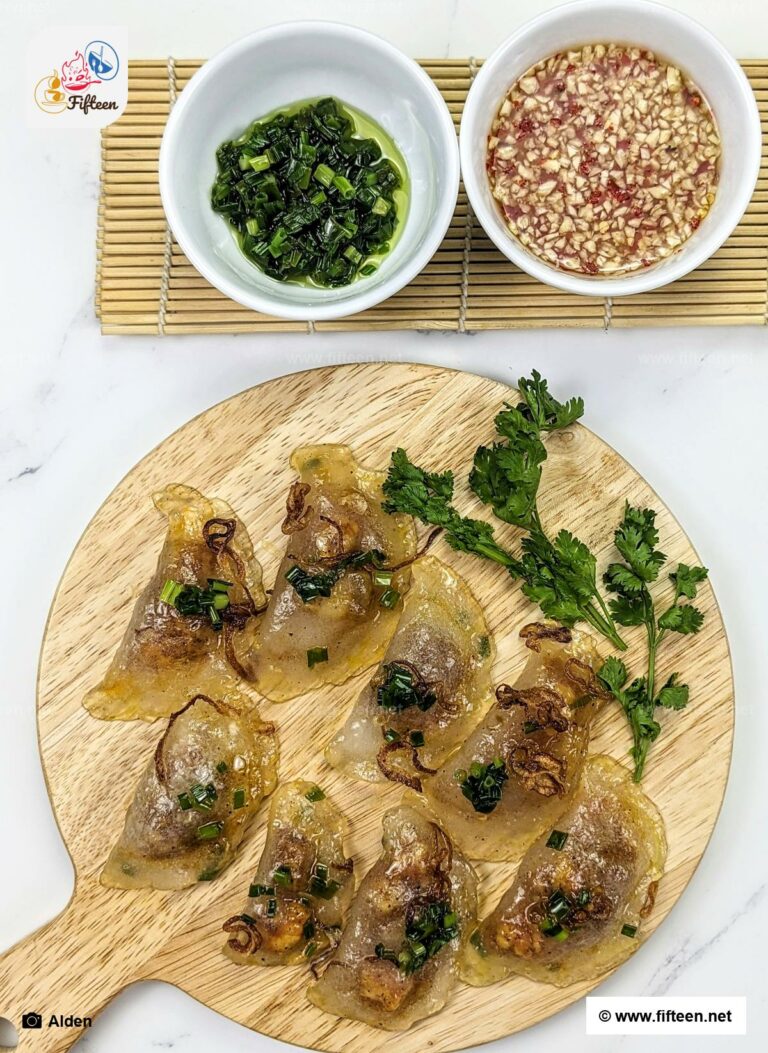
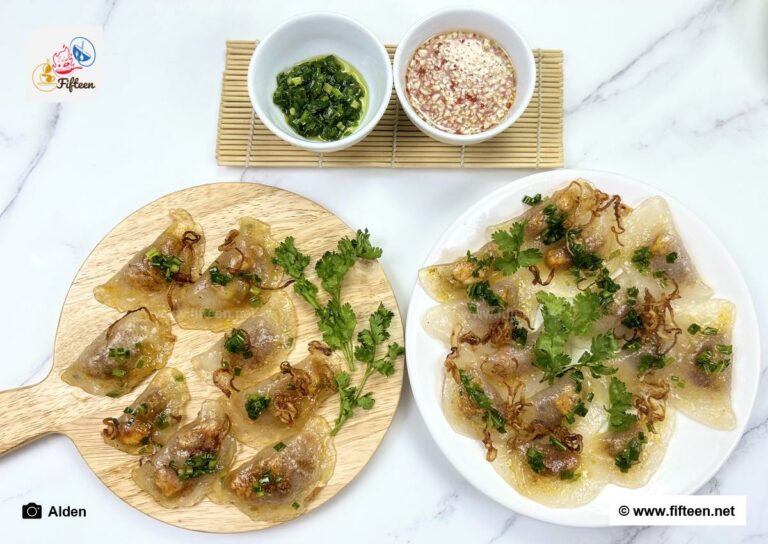
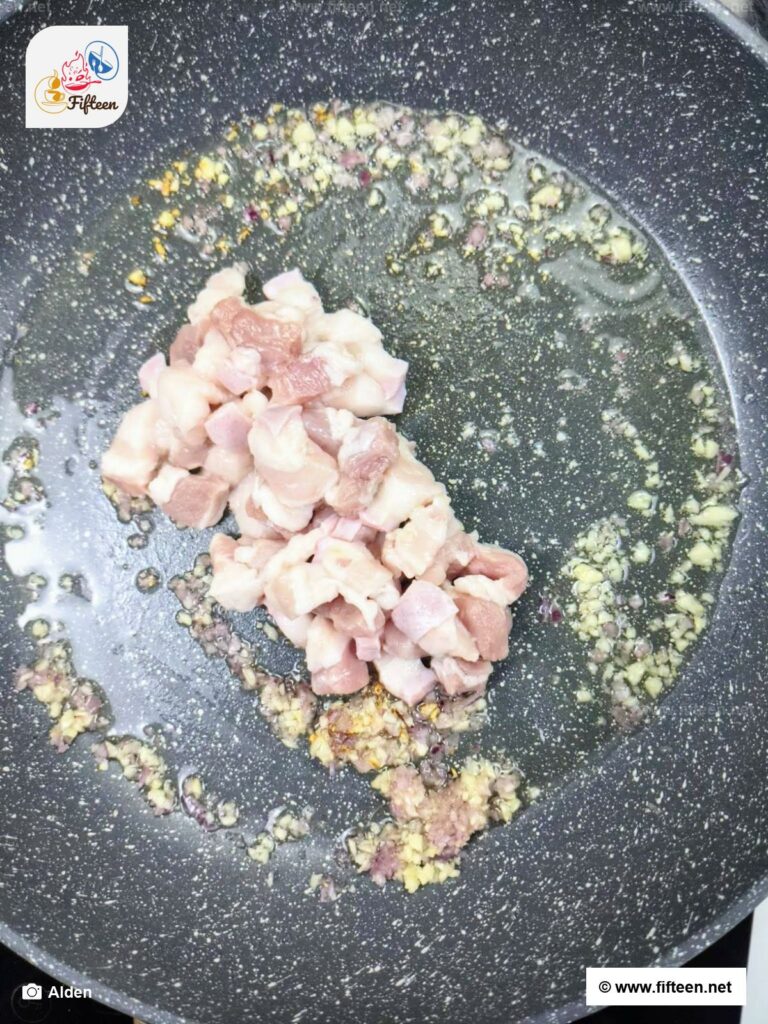
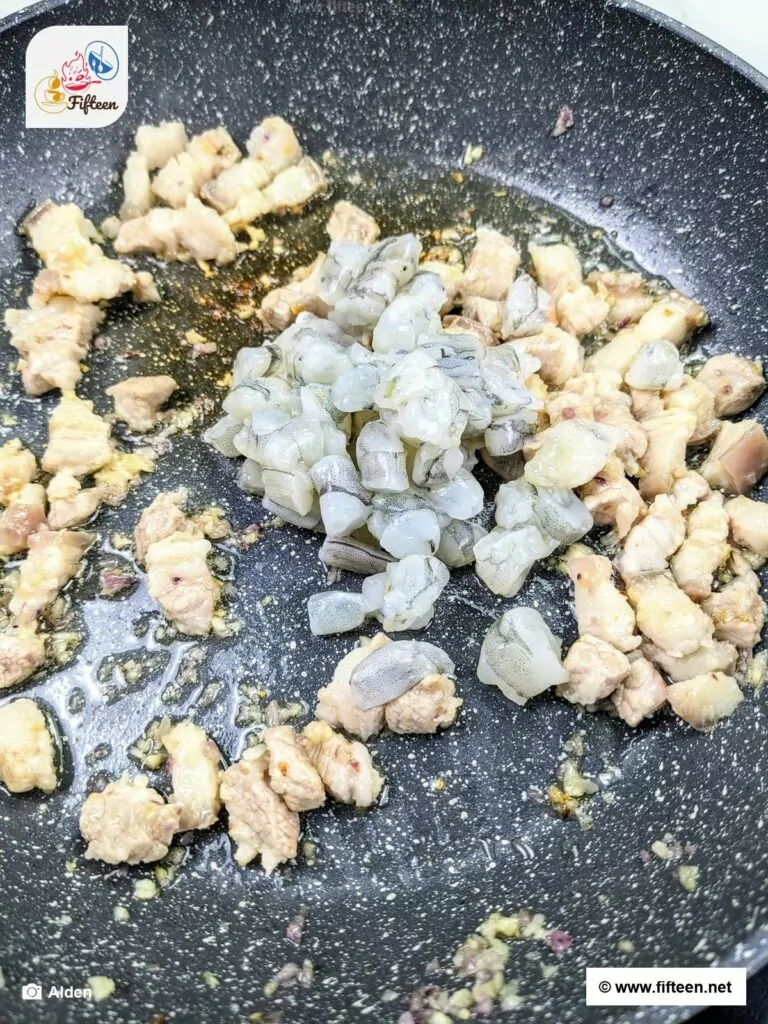
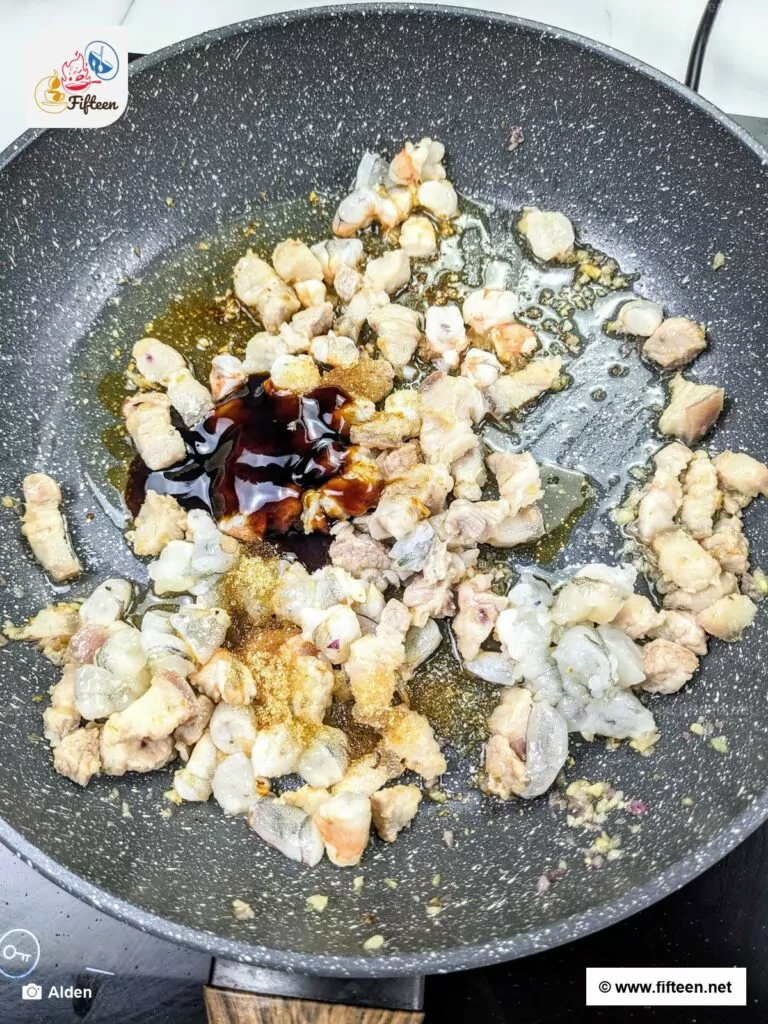
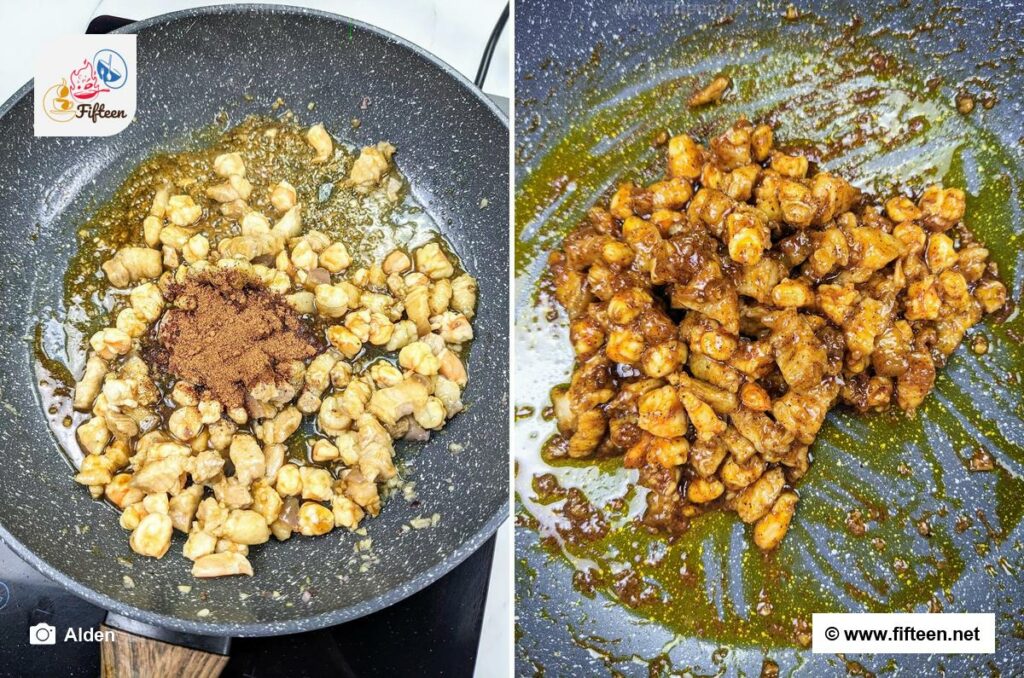
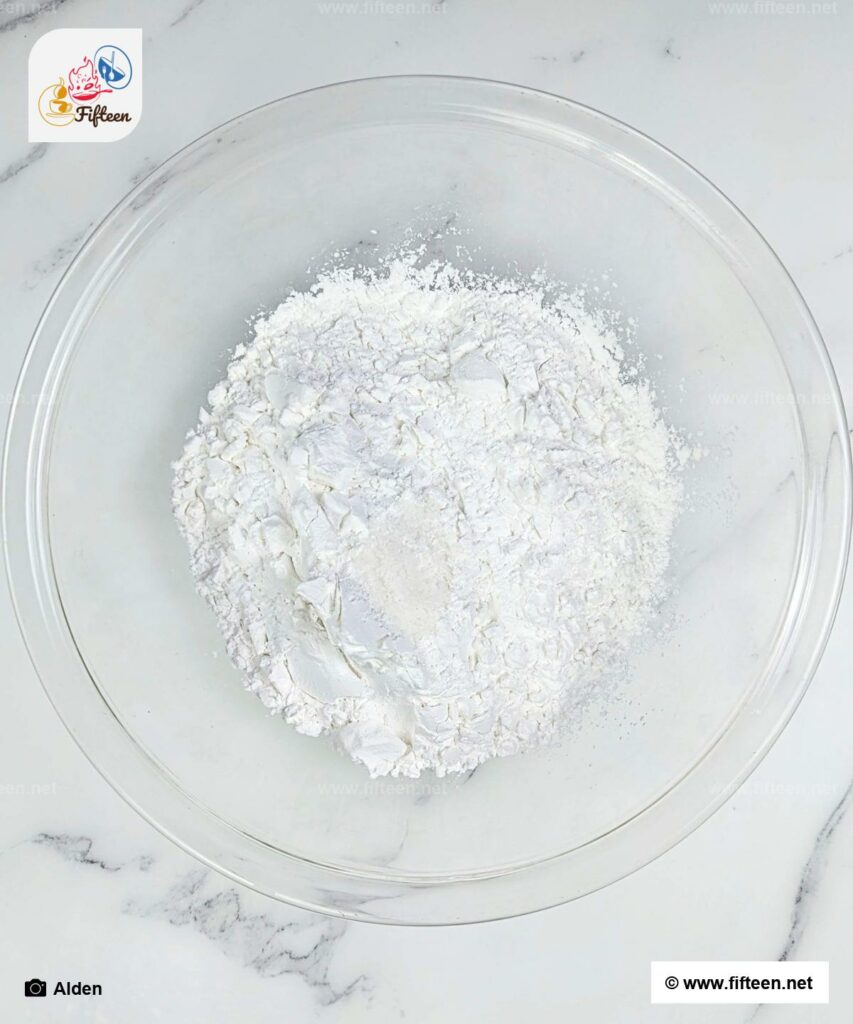
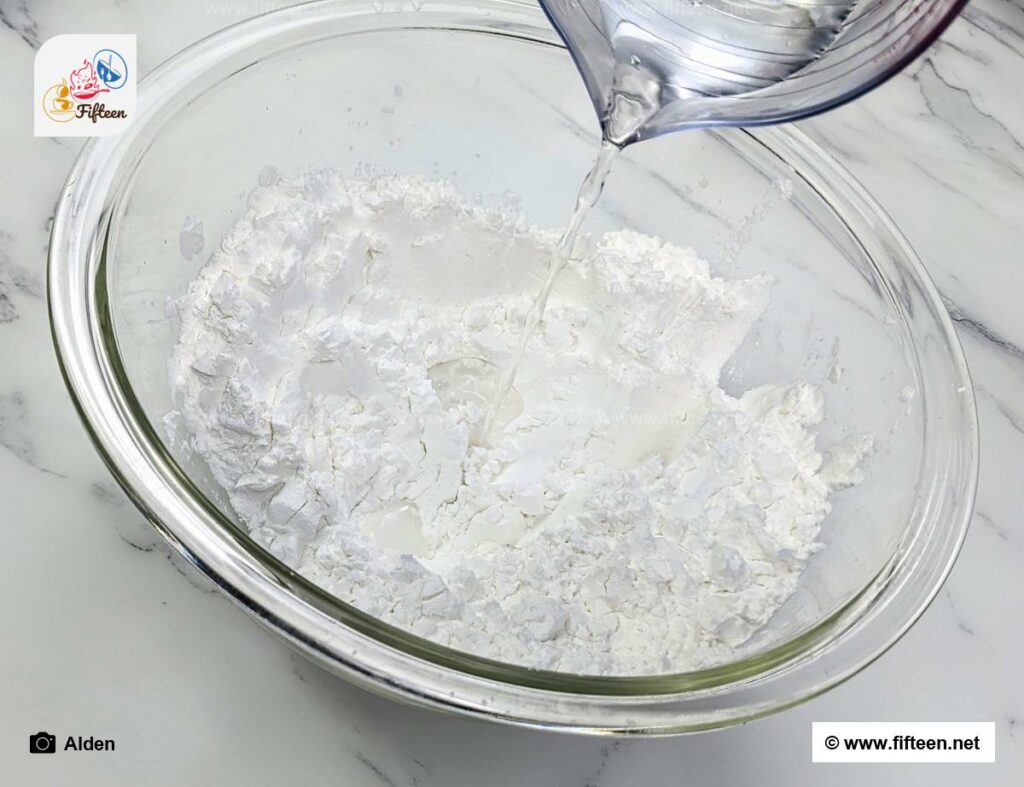
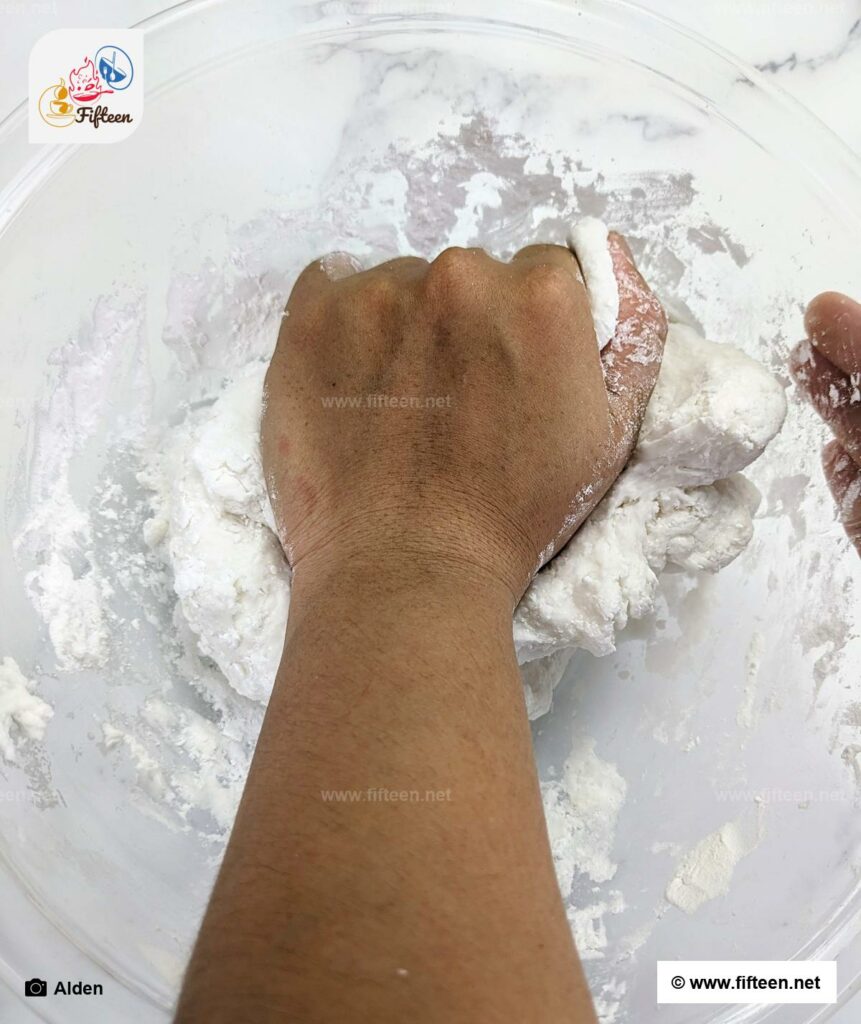
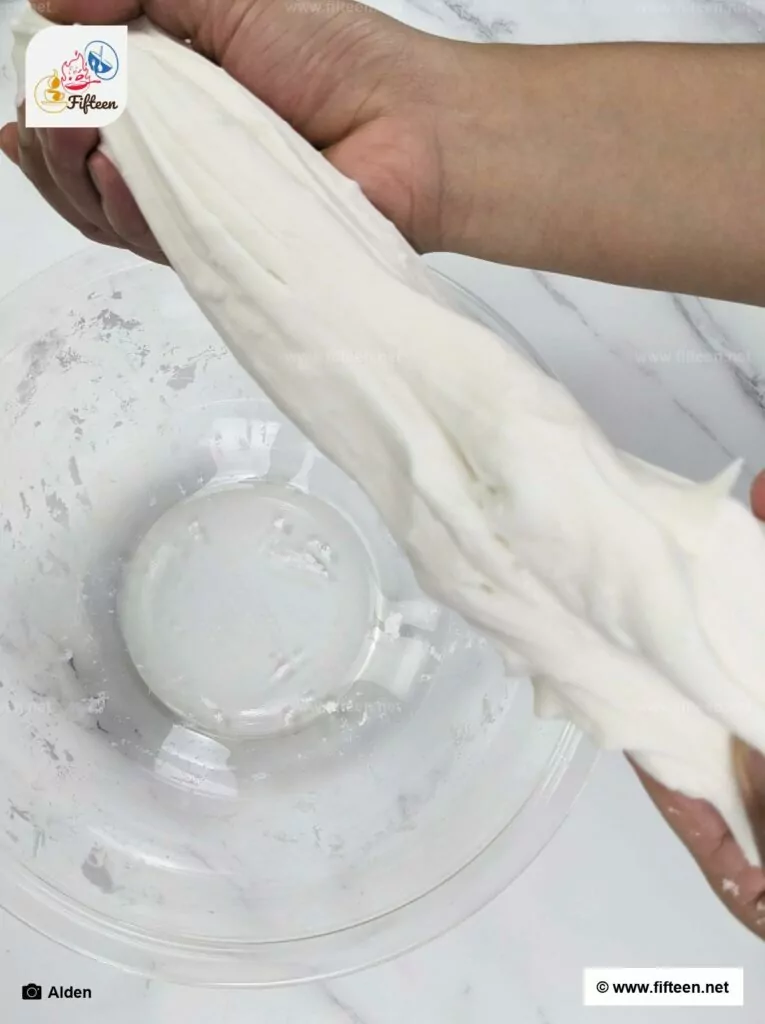
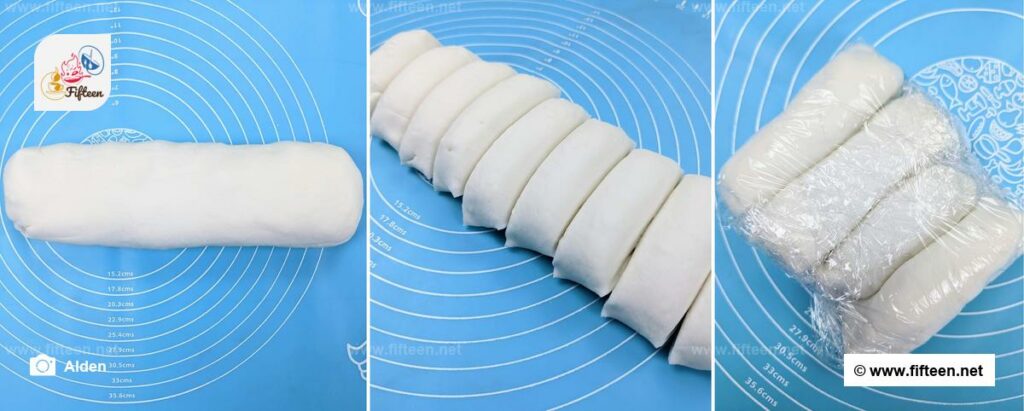
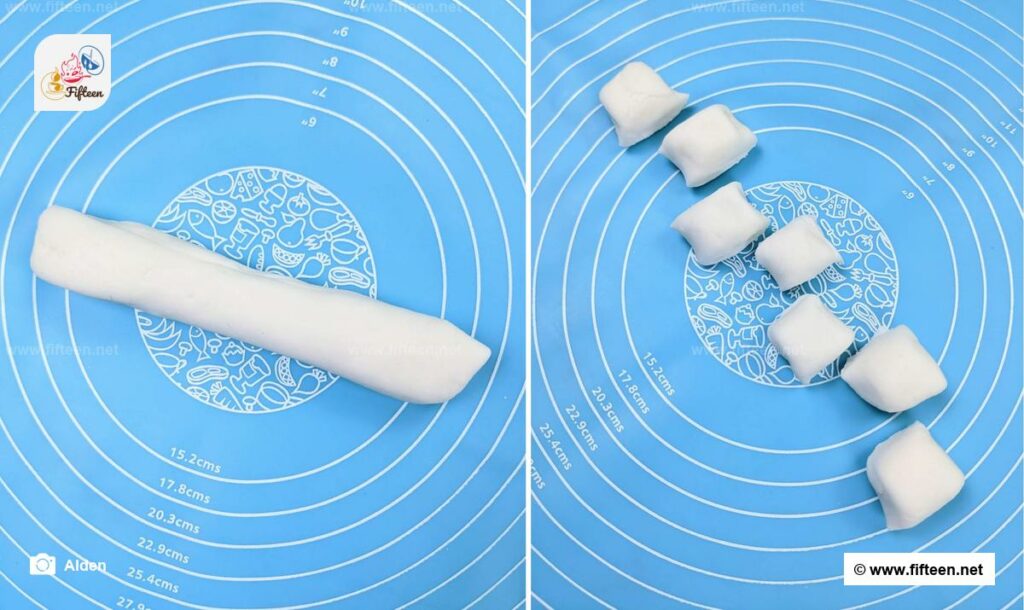
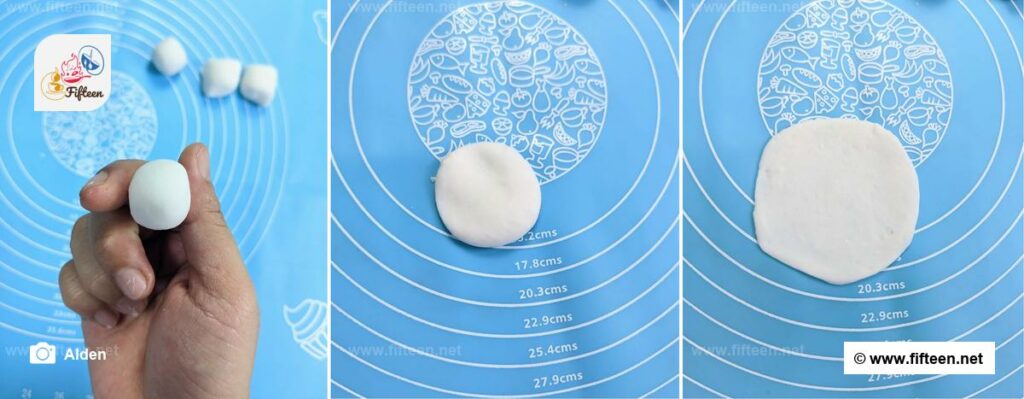
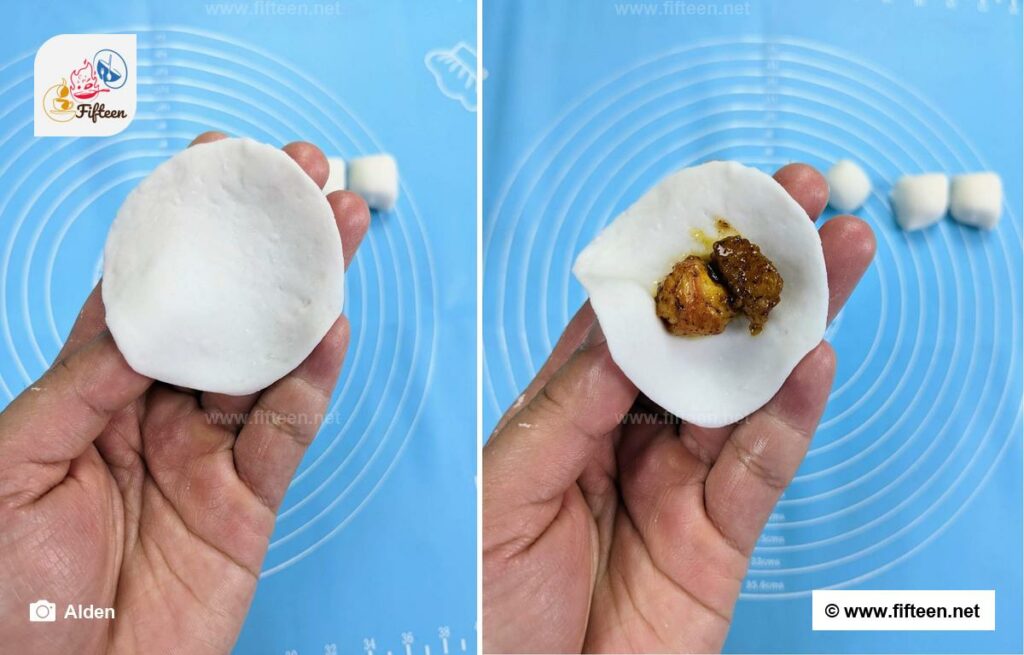
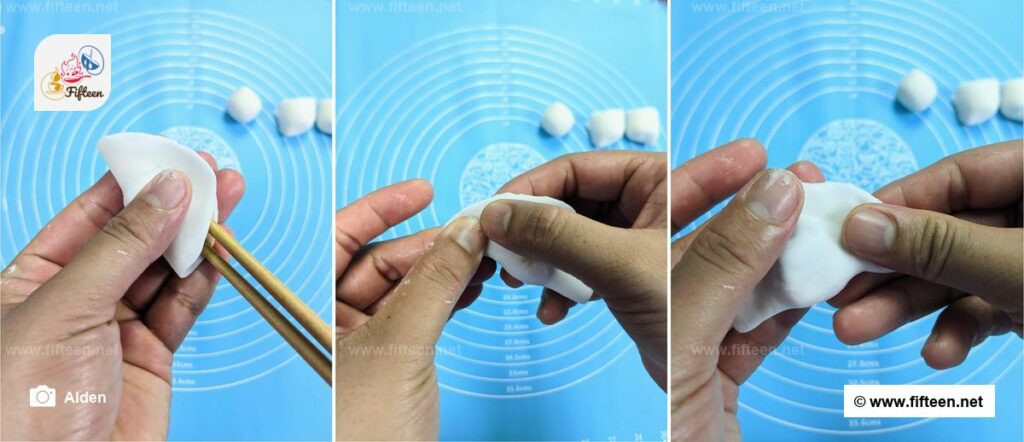
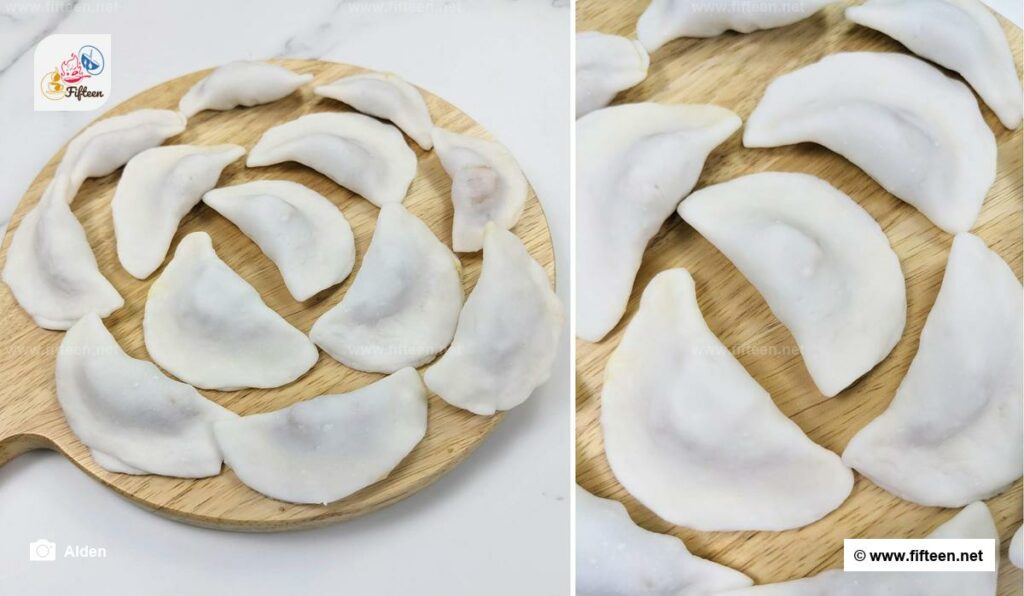
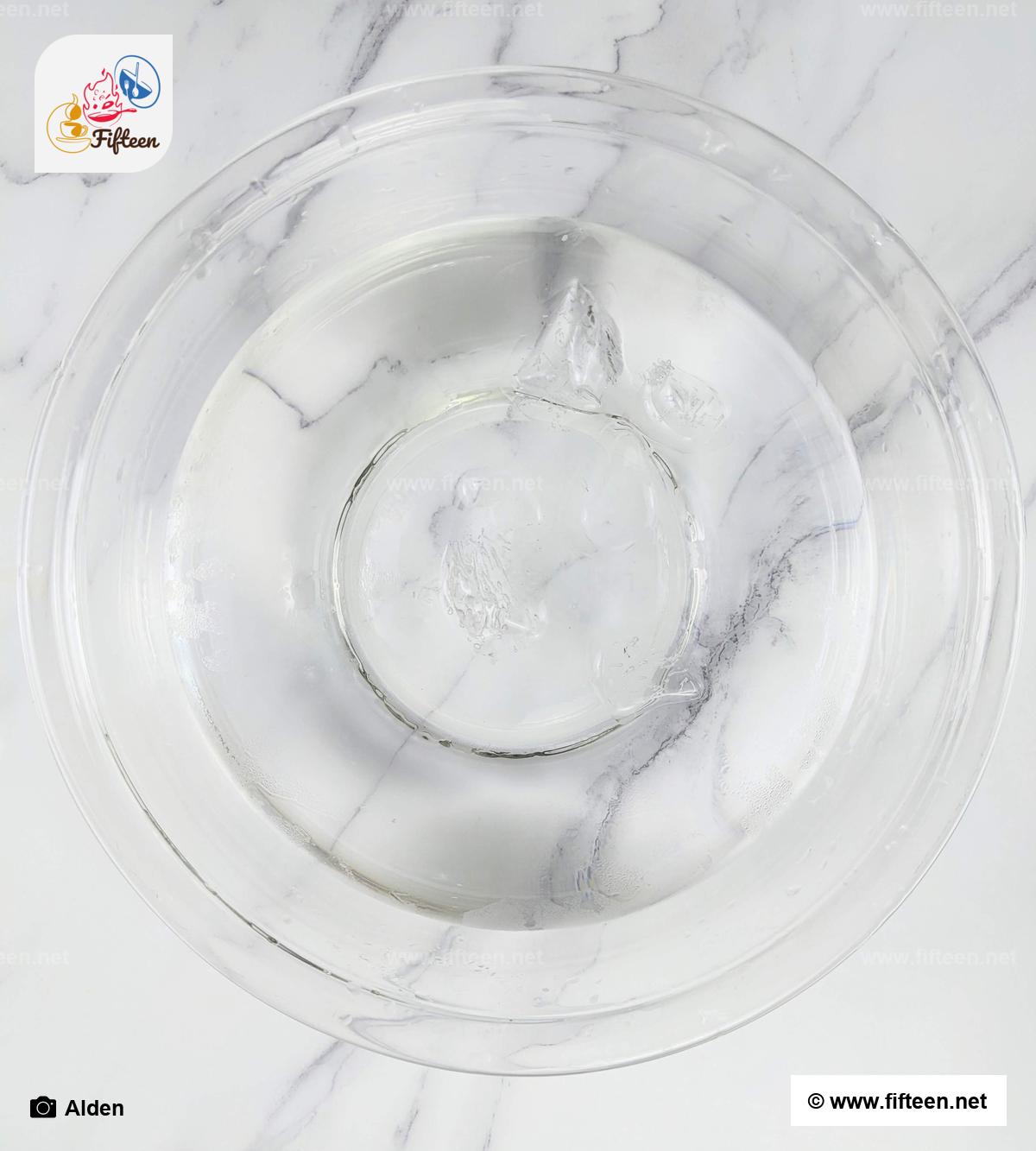
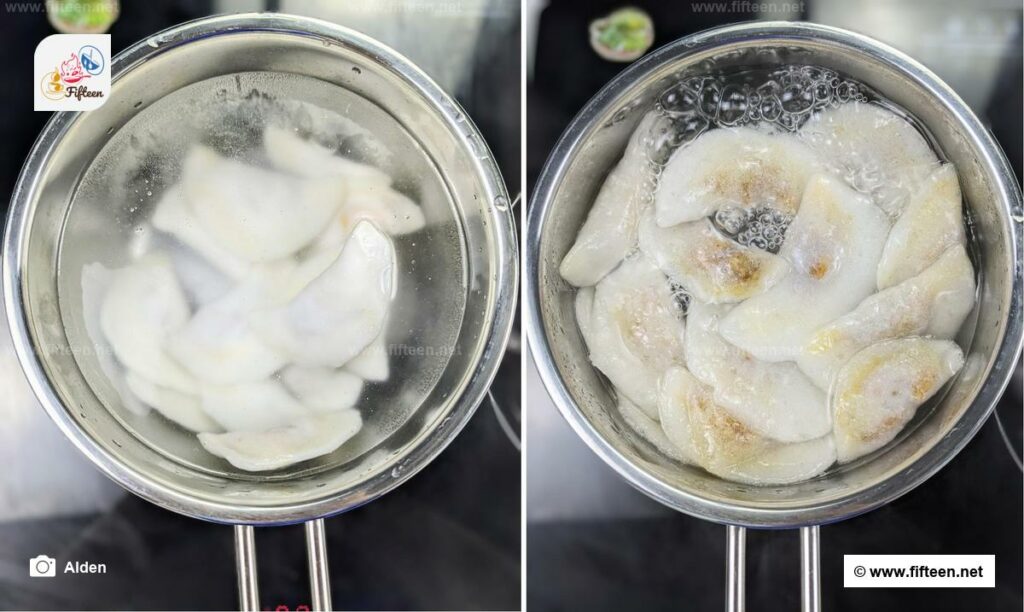

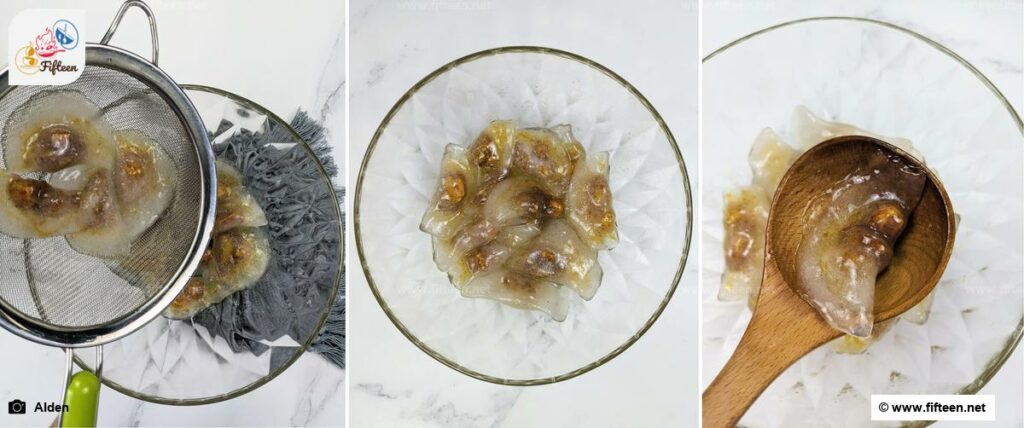
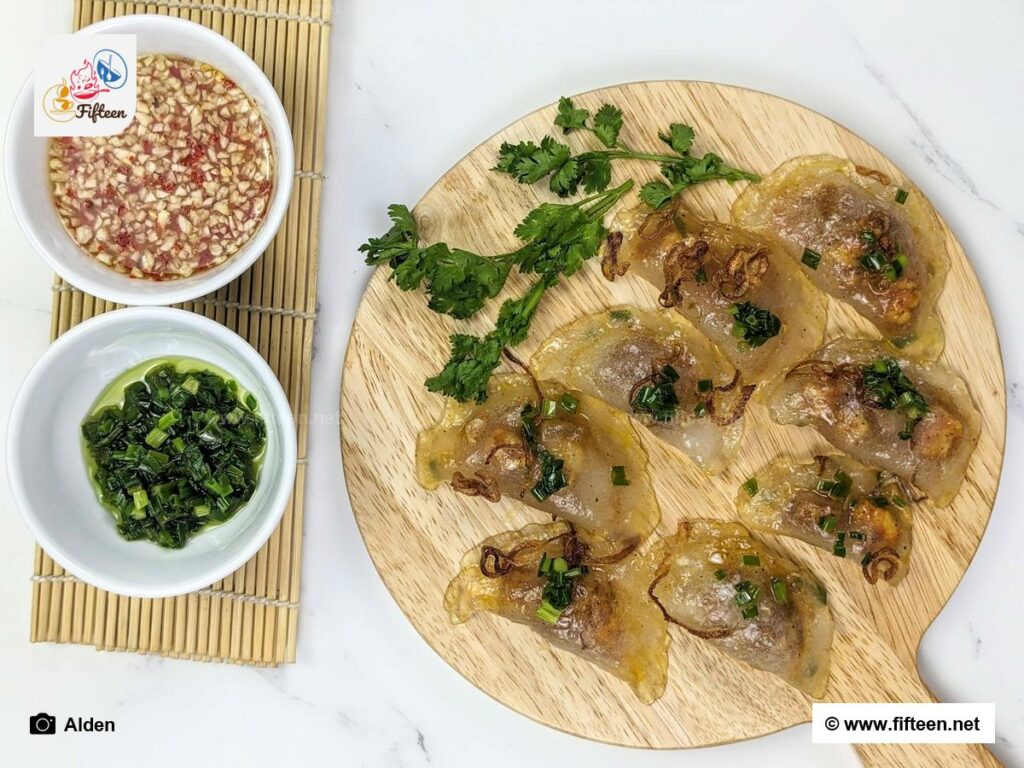
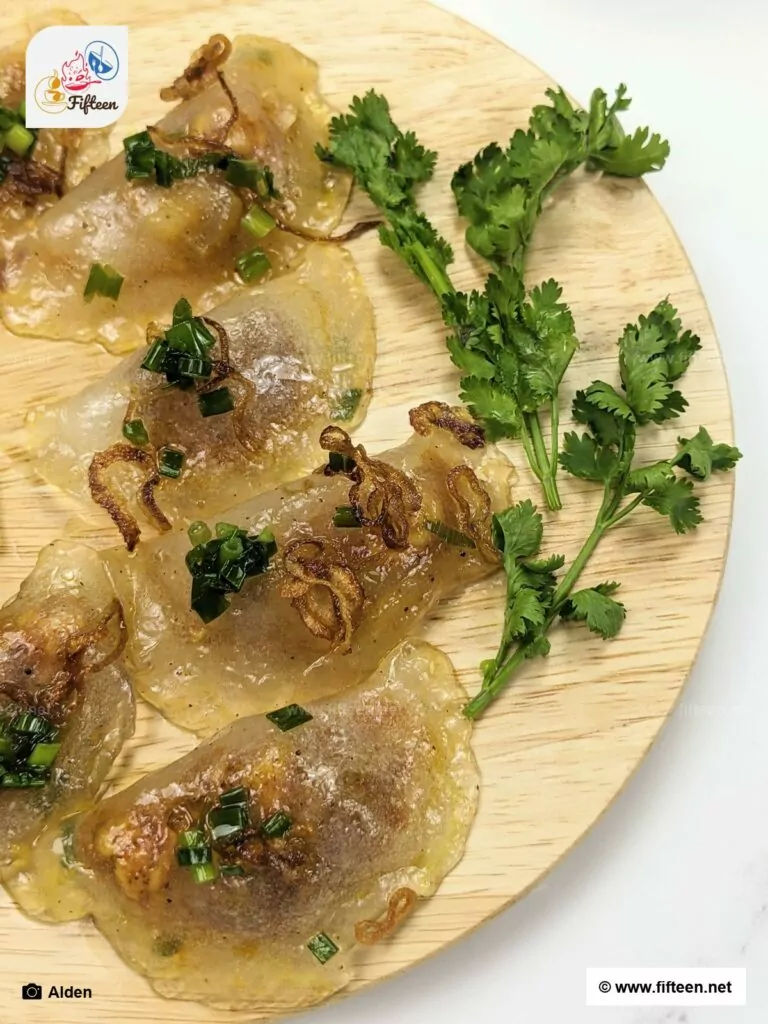
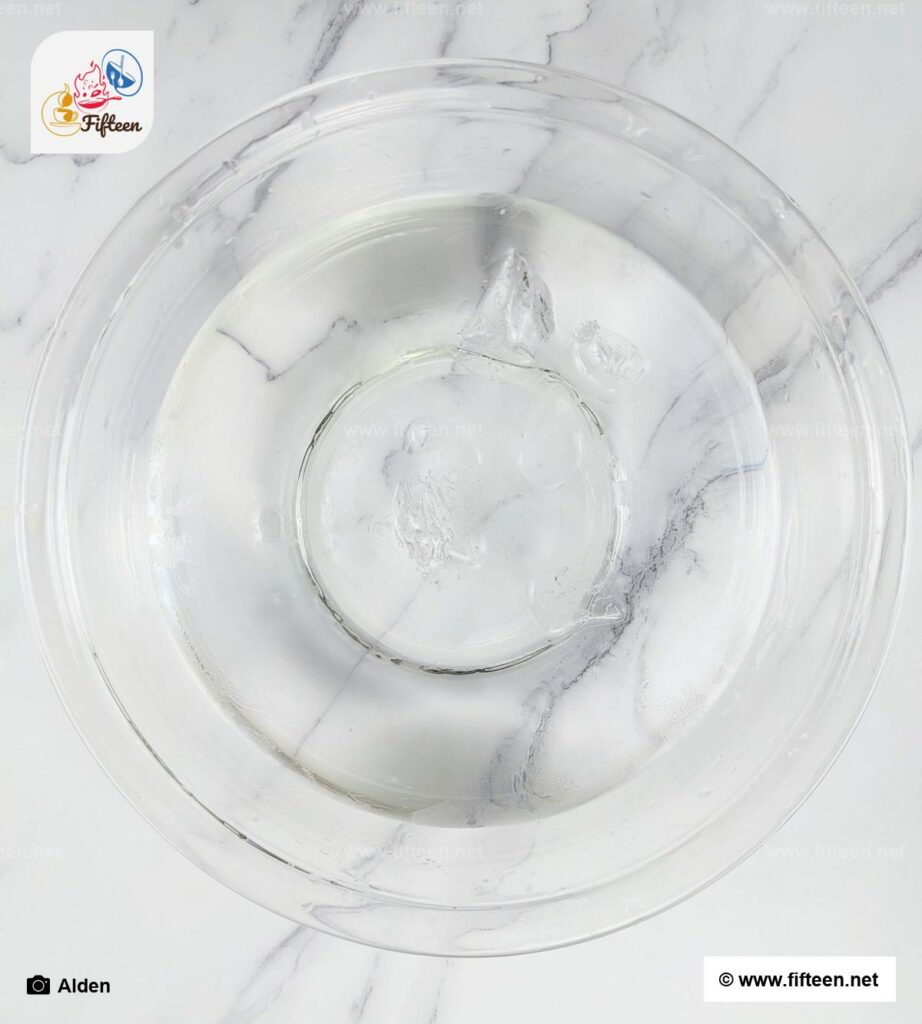
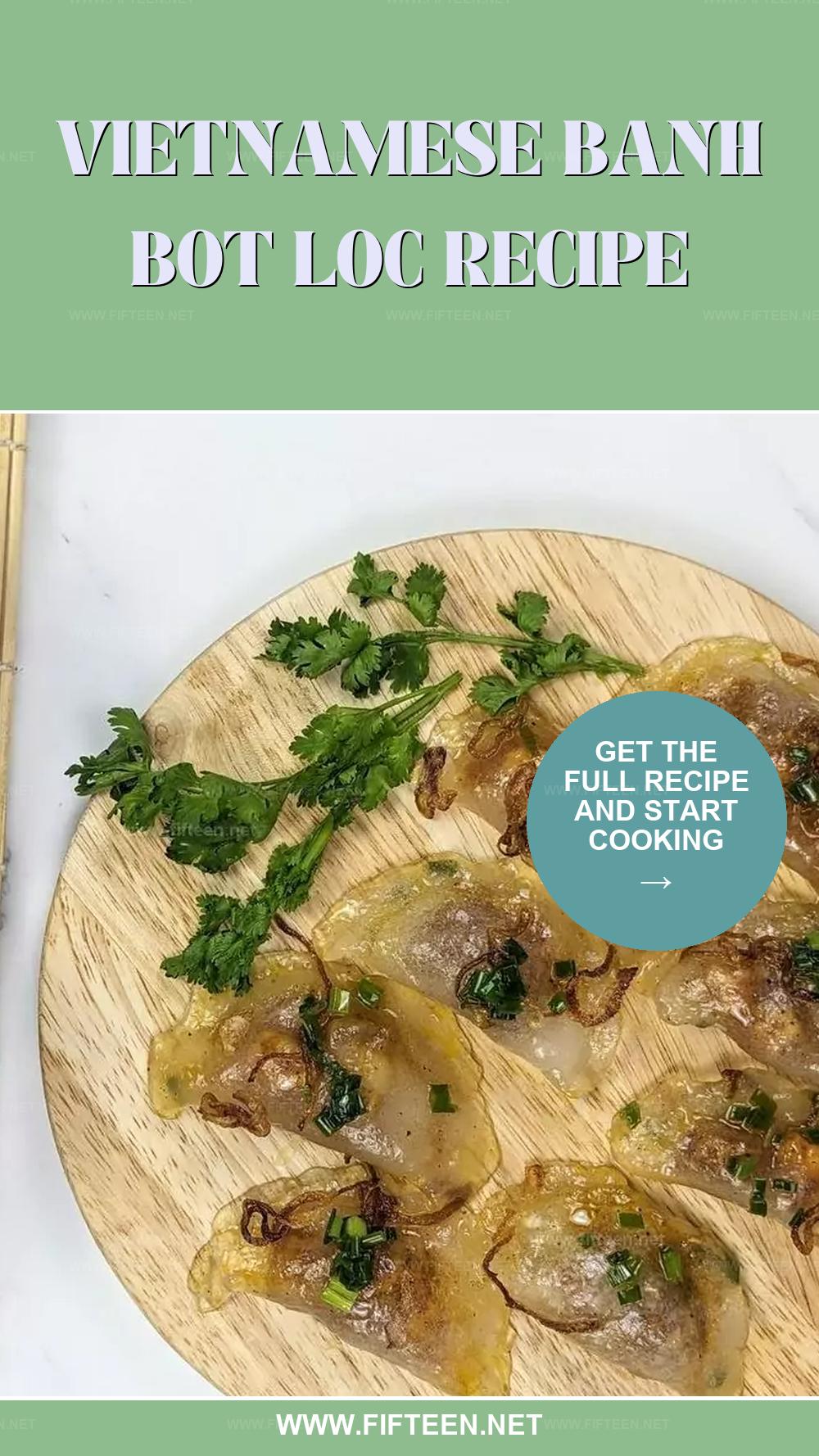
Tien – Alden
Content Writer
Expertise
Home Cooking, Recipe Development, Food Editor, Beverage Editor, Cooking-video Maker, Asian Food Content Creator
Education
Saigon Tourism College
Advanced Culinary Workshop, Beijing
Vietnamese Traditional Cooking School
American College of Vietnam
Alden is a skilled chef with expertise in Asian cuisines, known for blending traditional Vietnamese and Chinese cooking with contemporary innovations. Alden’s passion for Asian flavors and her creative approach to both food and beverages inspires fellow chefs and those aspiring to enter the field.